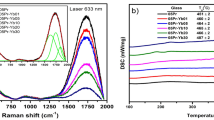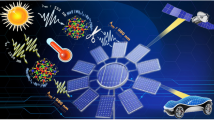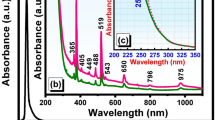Abstract
The use of uranyl doped glasses for solar energy conversion and concentration was discussed by Reisfeld and Neuman1. While the UO2+2 ion is an efficient energy converter, its maximum emission peaking around 500 nm does not coincide with the maximum sensitivity of the existing solar cells which is around 700–1,000 nm. The use of Nd3+ doped glasses for solar energy collectors was described by Levitt and Weber2. While the emission of Nd3+ peaking at 880 nm (4F3/2→4I9/2) and at 1.06 µm (4F3/2→4I11/2) is ideal for matching with the maximum sensitivity of solar cells, its absorbance arising from the forbidden transition 4f–4f is low and the overlap of the absorption spectrum of Nd3+ with the solar spectrum is rather weak. To increase the operational efficiency of solar collectors, a maximum overlap between the absorption spectrum of the collector and the solar spectrum is required3. In this report we suggest that glasses doped by uranyl and neodymium and uranyl and holmium increase the response to the solar spectrum, thus increasing the collection efficiency, and convert the absorbed light in the wide spectral range into the narrow fluorescence band at 1.06 µm and 880 nm in uranyl–neodymium glasses and 660 nm (5F5→5I8) and 750 nm (5F4, 5S2→5I7) in the uranyl-holmium co-doped glasses.
This is a preview of subscription content, access via your institution
Access options
Subscribe to this journal
Receive 51 print issues and online access
$199.00 per year
only $3.90 per issue
Buy this article
- Purchase on Springer Link
- Instant access to full article PDF
Prices may be subject to local taxes which are calculated during checkout
Similar content being viewed by others
References
Reisfeld, R. & Neuman, S. Nature 274, 144–145 (1977).
Levitt, J. A. & Weber, W. H. Appl. Optics. 16, 2684–2689 (1977).
Goetzberger, A. & Greubel, W. Appl. Phys. 14, 123–139 (1977).
Gandy, H. W., Ginter, R. J. & Weller, J. F. Appl. Phys. Lett. 4, 188–190 (1964).
Melamed, N. T., Hirayama, C. & French, P. W. Appl. Phys. Lett. 6, 43–45 (1965).
Reisfeld, R. & Jørgensen, C. K. Lasers and Excited States (Springer, Heidelberg, 1977).
Meinel, A. B. & Meinel, M. P. Applied Solar Energy, An Introduction. (Addison-Wesley, Massachusetts, 1976).
Author information
Authors and Affiliations
Rights and permissions
About this article
Cite this article
Reisfeld, R., Kalisky, Y. Improved planar solar converter based on uranyl neodymium and holmium glasses. Nature 283, 281–282 (1980). https://doi.org/10.1038/283281a0
Received:
Accepted:
Issue Date:
DOI: https://doi.org/10.1038/283281a0
This article is cited by
-
Efficient Cu+ to Ho3+ Energy Transfer in Highly CuO/SnO Co-doped Phosphate Glass
Journal of Inorganic and Organometallic Polymers and Materials (2018)
-
Light-Emitting Materials – Active Components of Luminescent Solar Concentrators
Theoretical and Experimental Chemistry (2014)
-
Energy transfer from Sm3+ to Er3+ in zinc phosphate glass
Indian Journal of Physics (2010)
-
Present state of research on luminescent solar concentrators (review)
Journal of Applied Spectroscopy (1991)
Comments
By submitting a comment you agree to abide by our Terms and Community Guidelines. If you find something abusive or that does not comply with our terms or guidelines please flag it as inappropriate.



